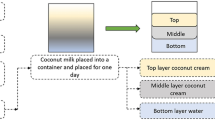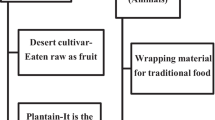Abstract
Citrus peels are underutilized in the processing industry and are commonly considered as waste as their chemical composition varies. However, it is possible to recover some value-added products, one of them being essential oil, which is widely used in the food industry. Due to the current increase in global demand for citrus essential oils, it is necessary to implement processes directed to the maximum recovery of oil from waste peels. Numerous efforts have been made without achieving significant improvements in yields. In this work, enzymatic pretreatments of orange, lemon, and grapefruit peels were applied to achieve increased yields of essential oil extracted by hydro-distillation. In two of the sources it was possible to increase the essential oil yield from two to six times. Moreover, a significant amount of fermentable sugars which can be used in the production of certain other compounds of interest through fermentation was obtained.
Similar content being viewed by others
References
Alonso-Gutierrez, J., Chan, R., Batth, T. S., Adams, P. D., Keasling, J. D., Petzold, C. J., & Lee, T. S. (2013). Metabolic engineering of Escherichia coli for limonene and perillyl alcohol production. Metabolic Engineering, 19, 33—41. DOI: 10.1016/j.ymben.2013.05.004.
AOAC International (2012). Official methods of analysis of AOAC International (19th ed.). Gaithersburg, MD, USA: AOAC International.
Berna, A., Tarrega, A., Blasco, M., & Subirats, S. (2000). Supercritical CO2 extraction of essential oil from orange peel; effect of the height of the bed. Journal of Supercritical Fluids, 18, 227–237. DOI: 10.1016/s0896-8446(00)00082-6.
Bhat, M. K. (2000). Cellulases and related enzymes in biotechnology. Biotechnology Advances, 18, 355—383. DOI: 10.1016/s0734-9750(00)00041-0.
Blanco Tirado, C., Stashenko, E. E., Combariza, M. Y., & Martínez, J. R. (1995). Comparative study of Colombian citrus oils by high-resolution gas chromatography and gas chromatography-mass spectrometry. Journal of Chromatography A, 697, 501–513. DOI: 10.1016/0021-9673(94)00955-9.
Boluda-Aguilar, M., & López-Gómez, A. (2013). Production of bioethanol by fermentation of lemon (Citrus limon L.) peel wastes pretreated with steam explosion. Industrial Crops and Products, 41, 188–197. DOI: 10.1016/j.indcrop.2012.04.031.
Bousbia, N., Abert-Vian, M., Ferhat, M. A., Meklati, B. Y., & Chemat, F. (2009). A new process for extraction o essential oil from Citrus peels: Microwave hydrodiffusion and gravity. Journal of Food Engineering, 90, 409–413. DOI: 10.1016/j.jfoodeng.2008.06.034.
Choi, I. S., Kim, J. H., Wi, S. G., Kim, K. H., & Bae, H. J. (2013). Bioethanol production from mandarin (Citrus unshiu) peel waste using popping pretreatment. Applied Energy, 102, 204–210. DOI: 10.1016/j.apenergy.2012.03.066.
Coll, L., Saura, D., Ruiz, M. P., Ros, J. M., Cánovas, L. A., & Laencina, J. (1995). Viscometric control in the enzymatic extraction of citrus peel oils. Food Control, 5, 143–146. DOI: 10.1016/0956-7135(95)00010-o.
FAO (2012). Comercio y mercados. Mercados de productos agrícolas. Frutos cítricos. Retrieved November 26, 2014, from http://www.fao.org (in Spanish)
Ferhat, M. A., Meklati, B. Y., Smadja, J., & Chemat, F. (2006). An improved microwave Clevenger apparatus for distillation of essential oil from orange peel. Journal of Chromatography A, 1112, 121–126. DOI: 10.1016/j.chroma.2005.12.030.
Guo, X. F., Han, D. M., Xi, H. P., Rao, L., Liao, X. J., Hu, X. S., & Wu, J. H. (2012). Extraction of pectin from navel orange peel assisted by ultra-high pressure, microwave or traditional heating: A comparison. Carbohydrate Polymers, 88, 441–448. DOI: 10.1016/j.carbpol.2011.12.026.
Hegazy, M. E. F., Mohamed, T. A., ElShamy, A. I., Mohamed, A. E. H. H., Mahalel, U. A., Reda, E. H., Shaheen, A. M., Tawfik, W. A., Shahat, A. A., Shams, K. A., Abdel-Azim, N. S., & Hammouda, F. M. (2015). Microbial biotransformation as a tool for drug development based on natural products from mevalonic acid pathway: A review. Journal of Advanced Research, 6, 17–33. DOI: 10.1016/j.jare.2014.11.009.
Hosni, K., Zahed, N., Chrif, R., Abid, I., Medfei, W., Kallel, M., Brahim, N. B., & Sebei, H. (2010). Composition of peel essential oils from four selected Tunisian Citrus species: Evidence for the genotypic influence. Food Chemistry, 123, 1098–1104. DOI: 10.1016/j.foodchem.2010.05.068.
Lago, S., Rodríguez, H., Arce, A., & Soto, A. (2014). Improved concentration of citrus essential oil by solvent extraction with acetate ionic liquids. Fluid Phase Equilibria, 361, 37–44. DOI: 10.1016/j.fluid.2013.10.036.
Lohrasbi, M., Pourbafrani, M., Niklasson, C., & Taherzadeh, M. J. (2010). Process design and economic analysis of a citrus waste biorefinery with biofuels and limonene as products. Bioresource Technology, 101, 7382–7388. DOI: 10.1016/j.biortech.2010.04.078.
Marín, F. R., Soler-Rivas, C., Benavente-García, O., Castillo, J., & Pérez-Alvarado, J. A. (2007). By-products from different citrus processes as a source of customized functional fibers. Food Chemistry, 100, 736–741. DOI: 10.1016/j.foodchem.2005.04.040.
Masmoudi, M., Besbes, S., Chaabouni, M., Robert, C., Paquot, M., Blecker, C., & Attia, H. (2008). Optimization of pectin extraction from lemon by-product with acidified date juice using response surface methodology. Carbohydrate Polymers, 74, 185–192. DOI: 10.1016/j.carbpol.2008.02.003.
Minh Tu, N. T., Thanh, L. X., Une, A., Ukeda, H., & Sawamura, M. (2002). Volatile constituents of Vietnamese pummelo, orange, tangerine and lime peel oils. Flavour and Fragrance Journal, 17, 169–174. DOI: 10.1002/ffj.1076.
Misharina, T. A., Terenina, M. B., Krikunova, N. I., & Kalinichenko, M. A. (2011). The influence of the composition of essential lemon oils o their antioxidant properties and the stability of the components. Russian Journal of Bioorganic Chemistry, 37, 883–887. DOI: 10.1134/s1068162011070168.
Nelson, N. (1944). A photometric adaptation of the Somogyi method for the determination of glucose. The Journal of Biological Chemistry, 153, 375–380.
Njoroge, S. M., Koaze, H., Karanja, P. N., & Sawamura, M. (2005). Volatile constituents of redblush grapefruit (Citrus paradisi) and pummelo (Citrus grandis) peel essential oil from Kenya. Journal of Agricultural and Food Chemistry, 53, 9790–9794. DOI: 10.1021/jf051373s.
Oberoi, H. S., Vadlani, P. V., Nanjundaswamy, A., Bansal, S., Singh, S., Kaur, S., & Babbar, N. (2011). Enhanced ethanol production from Kinnow mandarin (Citrus reticulata) waste via a statistically optimized simultaneous saccharification and fermentation process. Bioresource Technology, 102, 1593–1601. DOI: 10.1016/j.biortech.2010.08.111.
Pourbafrani, M., Forgacs, G., Sarvari Horvath, I., Niklasson, C., & Taherzadeh, M. J. (2010). Production of biofuels, limonene and pectin from citrus wastes. Bioresource Technology, 101, 4246–4250. DOI: 10.1016/j.biortech.2010.01.077.
Raeissi, S., Diaz, S., Espinosa, S., Peters, C. J., & Brignole, E. A. (2008). Ethane as an alternative solvent for supercritical extraction of orange peel oils. The Journal of Supercritical Fluids, 45, 306–313. DOI: 10.1016/j.supflu.2008.01.008.
Rezzadori, K., Benedetti, S., & Amante, E. R. (2012). Proposals for the residues recovery: Orange waste as raw material for new products. Food and Bioproducts Processing, 90, 606–614. DOI: 10.1016/j.fbp.2012.06.002.
Rezzoug, S. A., & Louka, N. (2009). Thermomechanical process intensification for oil extraction from orange peels. Innovative Food Science & Emerging Technologies, 10, 530–536. DOI: 10.1016/j.ifset.2009.05.008.
Rivas, B., Torrado, A., Torre, P., Convertí, A., & Domínguez, J. M. (2008). Submerged citric acid fermentation on orange peel autohydrolysate. Journal of Agricultural and Food Chemistry, 56, 2380–2387. DOI: 10.1021/jf073388r.
Rojas, J. P. L., Perea, A. V., & Stashenko, E. E. (2009). Obtención de aceites esenciales y pectinas a partir de subproductos de jugos cítricos. Vitae, Revista de la Facultad de Química Farmacéutica, 16, 110–115. (in Spanish)
Sahraoui, N., Abert-Vian, M., El Maataoui, M., Boutekedjiret, C., & Chemat, F. (2011). Valorization of citrus byproducts using microwave steam distillation (MSD). Innovative Food Science & Emerging Technologies 12, 163–170. DOI: 10.1016/j.ifset.2011.02.002.
Singh, P., Shukla, R., Prakash, B., Kumar, A., Singh, S., Mishra, P. K., & Dubey, N. K. (2010). Chemical profile, anifungal, antiaflatoxigenic and antioxidant activity of Citrus maxima Burm. and Citrus sinensis (L.) Osbeck essential oils and their cyclic monoterpene, dl-limonene. Food and Chemical Toxicology, 48, 1734–1740. DOI: 10.1016/j.fct.2010.04.001.
Sowbhagya, H. B., Sushma, S. B., Rastogi, N. K., & Naidu, M. M. (2013). Effect of pretreatments on extraction of pigment from marigold flower. Journal of Food Science and Technolgy, 50, 122–128. DOI: 10.1007/s13197-011-0313-4.
Ueno, H., Tanaka, M., Hosino, M., Sasaki, M., & Goto, M. (2008). Extraction of valuable compounds from the flavedo of Citrus junos using subcritical water. Separation and Purification Technology, 62, 513–516. DOI: 10.1016/j.seppur.2008.03.004.
Wilkins, M., Widmer, W. W., Grohmann, K., & Cameron, R. G. (2007). Hydrolysis of grapefruit peel waste with cellulase and pectinase enzymes. Bioresource Technology, 98, 1596–1601. DOI: 10.1016/j.biortech.2006.06.022.
Author information
Authors and Affiliations
Corresponding author
Rights and permissions
About this article
Cite this article
Chávez-González, M.L., López-López, L.I., Rodríguez-Herrera, R. et al. Enzyme-assisted extraction of citrus essential oil. Chem. Pap. 70, 412–417 (2016). https://doi.org/10.1515/chempap-2015-0234
Received:
Revised:
Accepted:
Published:
Issue Date:
DOI: https://doi.org/10.1515/chempap-2015-0234




